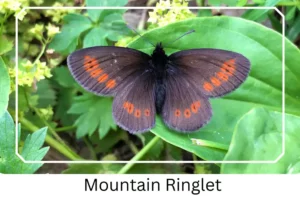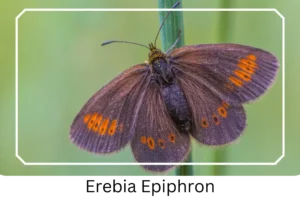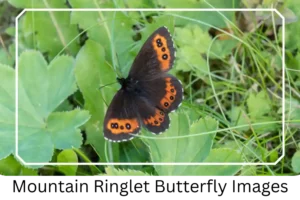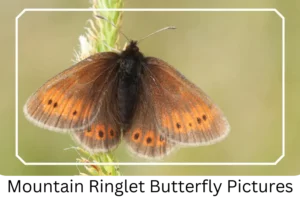Mountain Ringlet (Erebia epiphron)
The Mountain Ringlet (Erebia epiphron) is an enchanting species of butterfly that flourishes in the rugged terrains of Europe. Despite its widespread subspecies, it remains a jewel of the mountainous regions, celebrated for its elusive nature and distinct appearance. This butterfly, with its various life stages from caterpillar to adult, offers a glimpse into the resilience and beauty of alpine fauna.
Scientific Classification
- Family: Nymphalidae
- Genus: Erebia
- Common names: Small Mountain Ringlet
- Scientific Name: Erebia epiphron
Overview
The Mountain Ringlet is a small to medium-sized butterfly, recognized for its limited distribution across central and southern Europe. Adapting to life high in the mountains, this species has developed unique characteristics and behaviors that distinguish it from its counterparts in the butterfly kingdom. With a lifecycle intricately linked to its alpine environment, the Mountain Ringlet’s existence offers invaluable insights into the ecological balance of mountainous ecosystems.
Description and Identification
Caterpillar
The larva of the Mountain Ringlet is a sight to behold with its greenish hue, accented by darker green and yellowish lines. Sporting a brownish head, these caterpillars hatch after approximately 16 days, entering hibernation in October, preparing for their transformation.
Pupa
Measuring about 10 mm, the chrysalis of this species is modest in size but remarkable in coloration. A light green thorax and wing cases contrast with a greyish-white abdomen, marked by a distinctive blackish-brown streak. Hidden within grass tussocks in a silk case, the pupa stage is a critical three-week period of development.
Adult Butterfly
Sexual Dimorphism:
While sexual dimorphism is subtly present, it is the nuances in color and pattern that reveal the differences between males and females, with males often displaying slightly brighter hues.
Color and Appearance:
The adult Mountain Ringlet presents a base color of dull black that gracefully fades to the edges. The wings, both primary and secondary, are adorned with orange spots, each centered with a black dot. In contrast, the underside of the wings showcases a more subdued pattern, with the orange markings barely visible and only a few black dots.
Average Wingspan: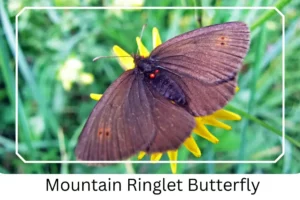
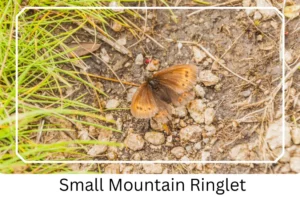
The wingspan of the Mountain Ringlet ranges from 16 to 22 mm (0.63 to 0.87 inches), a testament to its petite stature.
Flight Pattern:
Characterized by short, low flights, the Mountain Ringlet often pauses to bask in the sunlight, a behavior that adds to the charm of observing these butterflies in their natural habitat.
Eggs
Initially pale cream to yellow, the eggs of the Mountain Ringlet undergo a color transformation to fawn with darker markings. A female may lay up to 70 eggs individually, ensuring the continuation of the species.
Quick Facts | |
| Distribution | Predominantly found in the mountainous regions of central and southern Europe. |
| Habitat | Prefers sunny grasslands, warm mountain valleys, and forests, thriving in high-altitude environments. |
| Lifespan | The lifespan typically spans three months from June to August, influenced by altitude. |
| Host Plants | Mat-grass (Nardus stricta) is a known food source, though the full range of host plants remains to be discovered. |
| Adult Diet | Nectar and the yellow petals of Tormentil flowers constitute the diet of the adult Mountain Ringlet. |
How to Identify Mountain Ringlet?
Identifying the Mountain Ringlet butterfly involves looking for its distinct flight pattern and coloration. Unlike other butterflies, the Mountain Ringlet keeps close to the ground, flitting about in short bursts and pausing to bask in the sun. Its wings, when open, display a unique pattern of orange spots on a dark background, a feature less pronounced when the wings are closed. Observing these butterflies in their preferred habitats of sunny grasslands or mountainous valleys during their active months from June to August increases the chances of spotting them. Their small size and the subtle sexual dimorphism between males and females add layers of intrigue to their identification.
Did You Know?
- The Mountain Ringlet is the only true alpine butterfly species found in Britain, showcasing the country’s rich biodiversity.
- It holds the remarkable distinction of being the first butterfly species to recolonize the United Kingdom following the last ice age, highlighting its resilience and adaptability.
- Unlike many butterfly species, the Mountain Ringlet has adapted to thrive at high altitudes, making it a unique indicator of the health of alpine ecosystems.
Conclusion
The Mountain Ringlet butterfly is not just a species; it’s a symbol of nature’s adaptability and beauty. With its discreet presence in Europe’s mountainous regions, it invites enthusiasts and researchers alike to delve into the secrets of its survival and marvel at its lifecycle. By understanding and appreciating this butterfly, we can gain insights into the broader ecological narratives of our planet’s high-altitude environments.
Mountain Ringlet Pictures

Scientific Classification

- Family: Nymphalidae
- Genus: Erebia
- Common names: Small Mountain Ringlet
- Scientific Name: Erebia epiphron

